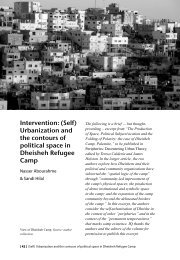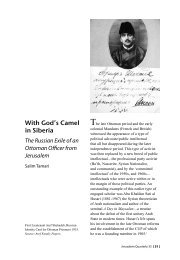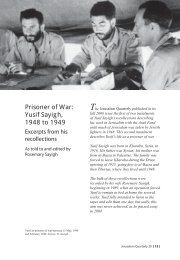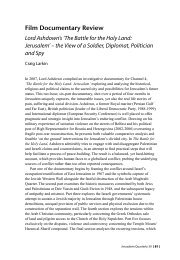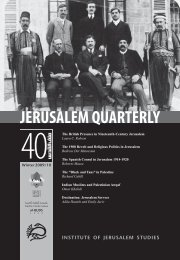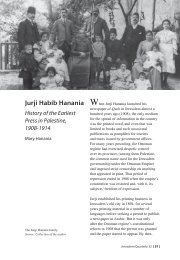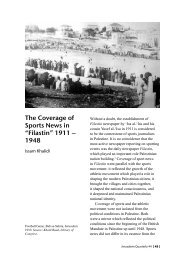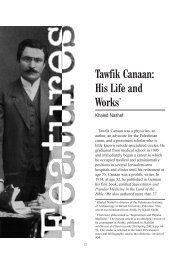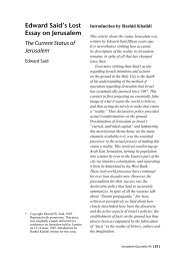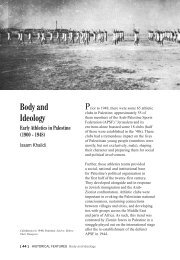Assassination in Jerusalem - Jerusalem Quarterly
Assassination in Jerusalem - Jerusalem Quarterly
Assassination in Jerusalem - Jerusalem Quarterly
You also want an ePaper? Increase the reach of your titles
YUMPU automatically turns print PDFs into web optimized ePapers that Google loves.
<strong>Assass<strong>in</strong>ation</strong> <strong>in</strong><br />
<strong>Jerusalem</strong>: Bahjat<br />
Abu Gharbiyah<br />
and Sami Al-<br />
Ansari’s Shoot<strong>in</strong>g<br />
of British Assistant<br />
Super<strong>in</strong>tendent<br />
Alan Sigrist 12th<br />
June 1936<br />
Matthew Hughes<br />
Palest<strong>in</strong>e disturbances 1936. Mach<strong>in</strong>e-gun<br />
mounted on a police truck. Source: Library of<br />
Congress.<br />
Introduction<br />
At midday on Friday, 12 June 1936 by<br />
Lions’ Gate just outside the Old City of<br />
<strong>Jerusalem</strong>, two armed Palest<strong>in</strong>ians, Bahjat<br />
Abu Gharbiyah and Sami al-Ansari, both<br />
teachers aged respectively twenty and<br />
eighteen, ambushed a car conta<strong>in</strong><strong>in</strong>g British<br />
act<strong>in</strong>g Assistant Super<strong>in</strong>tendent Alan Sigrist<br />
and his guard, British Constable Edmund<br />
Doxat. The assailants’ primary target was<br />
the senior officer, Sigrist, not Doxat. This<br />
was after almost two months <strong>in</strong>to the Arab<br />
revolt <strong>in</strong> Palest<strong>in</strong>e dur<strong>in</strong>g which Palest<strong>in</strong>ian<br />
and Arab rebels targeted British officials, <strong>in</strong><br />
protest aga<strong>in</strong>st Brita<strong>in</strong>’s policy of support<strong>in</strong>g<br />
Jewish immigration and settlement to the<br />
country. Sigrist was on his regular tour<br />
of the British police guard<strong>in</strong>g the gates<br />
of the Old City but as it was also the day<br />
for Friday prayers, British security was<br />
tighter than usual. As a young a cous<strong>in</strong> of<br />
al-Ansari, Serene Husse<strong>in</strong>i, recalled: “as<br />
<strong>Jerusalem</strong> <strong>Quarterly</strong> 44 [ 5 ]
the time for noon prayers drew closer. The streets were heavy with anger. As men<br />
and women entered the gates of the al Aqsa Mosque their faces betrayed worry and<br />
sadness.” 1<br />
Sigrist was driv<strong>in</strong>g a left-hand drive car on the right side of the road as cars had<br />
been <strong>in</strong>troduced to Palest<strong>in</strong>e <strong>in</strong> the Ottoman era, before the British – who drive on the<br />
left – arrived <strong>in</strong> 1917. 2 Doxat sat to Sigrist’s right <strong>in</strong> the passenger seat armed with a<br />
British Army-issue Lee-Enfield rifle as well as a Service revolver pistol. As the two<br />
men drove away from St. Stephen’s Gate follow<strong>in</strong>g Sigrist’s visit to the police picket<br />
there, the assass<strong>in</strong>s, who had been track<strong>in</strong>g Sigrist’s daily schedule, struck on the<br />
Jericho road just outside, shoot<strong>in</strong>g Sigrist as he was return<strong>in</strong>g to Herod’s Gate on the<br />
<strong>in</strong>cl<strong>in</strong>e by the Muslim cemetery a few meters before the turn at the northeast corner<br />
of the Old City walls. Sigrist be<strong>in</strong>g on the road-side of the car meant that the two<br />
assass<strong>in</strong>s had to step <strong>in</strong>to the middle of the road to shoot him, and as both men aimed<br />
at Sigrist this left Doxat temporarily free to return fire. The assass<strong>in</strong>s had chosen<br />
this spot as Sigrist’s car slowed on the <strong>in</strong>cl<strong>in</strong>e before the turn<strong>in</strong>g; Abu Gharbiyah’s<br />
memory is that both men were “calm and <strong>in</strong> full control of the situation” when they<br />
launched their attack. 3<br />
In June 2009, Abu Gharbiyah, now n<strong>in</strong>ety-three, consented to an <strong>in</strong>terview with<br />
this author at his home <strong>in</strong> Amman, Jordan. 4 His recollections supplemented by<br />
contemporary records provide a useful counter-narrative to the traditional British<br />
account of undiluted rebel terrorism, and one that this essay will go on to describe <strong>in</strong><br />
an attempt to explore the contested terra<strong>in</strong> of who used violence <strong>in</strong> Palest<strong>in</strong>e at this<br />
time and for what purpose. Us<strong>in</strong>g the shoot<strong>in</strong>g of Sigrist as a case study opens up<br />
wider debates on official and unofficial aggression, complement<strong>in</strong>g recent academic<br />
studies on Brita<strong>in</strong>’s use of force <strong>in</strong> Palest<strong>in</strong>e at this time, and giv<strong>in</strong>g voice to what<br />
Edward Said has described as the “<strong>in</strong>visible and <strong>in</strong>audible” Palest<strong>in</strong>ians who fought<br />
the British <strong>in</strong> the late 1930s. 5 That said, oral history and memory have their pitfalls.<br />
Thus, a British Palest<strong>in</strong>e police contemporary of Sigrist (and present at his funeral<br />
some twenty years ago) read this author’s account of Sigrist’s activities <strong>in</strong> <strong>Jerusalem</strong><br />
and remembered Sigrist as a “pleasant chap and a bit of a scholar,” a description that<br />
jars with the account that follows of Sigrist’s violence directed at Palest<strong>in</strong>ians, as<br />
readers will discover. 6<br />
The shoot<strong>in</strong>g of Sigrist gets little mention <strong>in</strong> the literature, not surpris<strong>in</strong>g<br />
consider<strong>in</strong>g the large number of attacks on British officials dur<strong>in</strong>g the revolt <strong>in</strong><br />
Palest<strong>in</strong>e. In Tom Segev’s One Palest<strong>in</strong>e, Complete (2000), the outrage is recorded<br />
simply as, “a young Arab [al-Ansari] opened fire on the car of a <strong>Jerusalem</strong> police<br />
officer, wound<strong>in</strong>g him. A British soldier returned fire; the Arab was hit and later<br />
died.” 7 The Palest<strong>in</strong>e Post reported that the two assass<strong>in</strong>s had hidden below the side of<br />
the Jericho road before the attack, a claim refuted by Abu Gharbiyah who later wrote<br />
that they were both walk<strong>in</strong>g openly <strong>in</strong> the street; other accounts have the men jump<strong>in</strong>g<br />
on and, <strong>in</strong> one case, <strong>in</strong>to the car. 8 Abu Gharbiyah hid his weapon under his tarbush<br />
while al-Ansari’s was <strong>in</strong> his pocket – both men had automatic pistols, Abu Gharbiyah<br />
an Italian Beretta and al-Ansari a French Lafayette. 9 Abu Gharbiyah and al-Ansari<br />
[ 6 ] <strong>Assass<strong>in</strong>ation</strong> <strong>in</strong> <strong>Jerusalem</strong>
fired together from about a meter away at Sigrist who was <strong>in</strong>side the car, shoot<strong>in</strong>g him<br />
twice <strong>in</strong> the chest and shoulder (or, more likely, one round caused both wounds), the<br />
latter a serious wound. The secondary target, Doxat, sat alongside his superior officer<br />
struggl<strong>in</strong>g with his rifle <strong>in</strong>side the conf<strong>in</strong>ed space of the car. Abu Gharbiyah and al-<br />
Ansari had agreed to fire slowly but Doxat managed to return fire with his pistol that<br />
he had previously drawn on see<strong>in</strong>g the two men loiter<strong>in</strong>g <strong>in</strong> the area, so al-Ansari<br />
shouted at Abu Gharbiyah to shoot more rapidly. 10 Doxat was quick to react as he was<br />
return<strong>in</strong>g fire at the same time or even before the two assass<strong>in</strong>s opened up with their<br />
weapons on Sigrist, shoot<strong>in</strong>g at first to his left across his comrade and through his<br />
open w<strong>in</strong>dow, a decisive reaction that would surely have deafened Sigrist. 11 Doxat and<br />
the assass<strong>in</strong>s also exchanged bullets through the shattered w<strong>in</strong>dscreen. In the mêlée,<br />
al-Ansari emptied his pistol and ran off, wounded, shot by Doxat <strong>in</strong> the fire-fight. His<br />
direction of flight is uncerta<strong>in</strong>, either to the south and east towards Gethsemane and<br />
the Kidron valley, or to the north towards Wadi el-Joz, accord<strong>in</strong>g to Abu Gharbiyah. 12<br />
Abu Gharbiyah fired off his last rounds at Doxat, some or all of the bullets deflected<br />
by the car’s (re<strong>in</strong>forced) glass or bodywork, aware that by chance an Army-escorted<br />
Jewish Potash Company convoy was approach<strong>in</strong>g from the southeast. Sigrist had<br />
slumped back when shot, releas<strong>in</strong>g his feet from the car’s pedals, so Doxat had shot al-<br />
Ansari while <strong>in</strong>side a vehicle roll<strong>in</strong>g backwards, under fire, pull<strong>in</strong>g on the hand-brake,<br />
and alongside his badly wounded superior officer – no mean feat.<br />
Recount<strong>in</strong>g the Events<br />
The history of the Palest<strong>in</strong>e police recounted that Doxat was able to “leap out” of the<br />
car and shoot al-Ansari; a contemporary newspaper report states that he “whipped<br />
out” his revolver and fired through the w<strong>in</strong>dscreen at one of his assailants. 13 The<br />
car rolled backwards off the road over a thirty- to fifty-foot drop <strong>in</strong>to a rocky wadi<br />
land<strong>in</strong>g upright with Sigrist and Doxat <strong>in</strong>side, both badly bruised, the eng<strong>in</strong>e still<br />
runn<strong>in</strong>g. 14 Abu Gharbiyah’s recollection is that Doxat had exited the vehicle before<br />
it went over the edge <strong>in</strong>to the wadi. 15 Filast<strong>in</strong> [Palest<strong>in</strong>e] newspaper noted that<br />
Doxat was wounded <strong>in</strong> the thigh but this does not appear to have been a gunshot; the<br />
Palest<strong>in</strong>e Post credited Doxat with a “slight” neck wound <strong>in</strong> addition to some “other<br />
<strong>in</strong>juries” susta<strong>in</strong>ed when the car fell <strong>in</strong>to the valley. 16 A private car took Sigrist to the<br />
Government Hospital <strong>in</strong> the ma<strong>in</strong> British headquarters at the “Russian Compound” <strong>in</strong><br />
west <strong>Jerusalem</strong>, where Doxat soon jo<strong>in</strong>ed him. On 14 June, Sigrist and Doxat were<br />
reportedly “cheerful” <strong>in</strong> hospital after the <strong>in</strong>cident and both recovered but Sigrist<br />
never returned to police work <strong>in</strong> Palest<strong>in</strong>e. Sigrist was still “cheerful” on the 15 June,<br />
<strong>in</strong> true British style; by September 1936, he was back <strong>in</strong> England. 17 Sigrist eventually<br />
returned to police duties, but not <strong>in</strong> Palest<strong>in</strong>e; he died peacefully on 1 March 1983,<br />
outliv<strong>in</strong>g al-Ansari but not Abu Gharbiyah.<br />
The crew and soldiers of the Potash Company convoy tracked the wounded al-<br />
Ansari and a police search with a dog quickly uncovered him hid<strong>in</strong>g <strong>in</strong> a nearby house;<br />
<strong>Jerusalem</strong> <strong>Quarterly</strong> 44 [ 7 ]
he died on the way to the hospital or “later” <strong>in</strong> hospital of his wounds. 18 Meanwhile,<br />
Abu Gharbiyah had made his way to Wadi el-Joz and returned to his family home<br />
<strong>in</strong>side the Old City near the Haram al Sharif via the Musrara neighbourhood and the<br />
New Gate <strong>in</strong> time to go off to Friday prayers at the al-Aqsa mosque with his brother,<br />
alive to the gossip spread<strong>in</strong>g about the recent outrage.<br />
How did al-Ansari die? Doxat had shot him <strong>in</strong> the chest – if Doxat was us<strong>in</strong>g a<br />
Webley Service pistol, this fired a powerful round 19 – but al-Ansari was alive when<br />
captured and be<strong>in</strong>g tended <strong>in</strong> a house by two local men, both of whom the British also<br />
arrested. Abu Gharbiyah ma<strong>in</strong>ta<strong>in</strong>s that al-Ansari was “conscious” when he reached<br />
the hospital. 20 In the end, al-Ansari ended up <strong>in</strong> Government Hospital alongside Sigrist<br />
and Doxat. Abu Gharbiyah details British soldiers throw<strong>in</strong>g al-Ansari onto the back<br />
of a lorry and deny<strong>in</strong>g him first aid, after which <strong>in</strong> hospital he told police Crim<strong>in</strong>al<br />
Investigation Department (CID) officers who had rushed to <strong>in</strong>terview him that he had<br />
acted alone, which they must have known was untrue. 21 The Palest<strong>in</strong>ian educator and<br />
writer Khalil al-Sakak<strong>in</strong>i recorded how soldiers beat al-Ansari, with rifle butts, <strong>in</strong> the<br />
lorry on the way to the hospital. 22 This could be true as across Palest<strong>in</strong>e dur<strong>in</strong>g the<br />
revolt the police allegedly tortured and assass<strong>in</strong>ated suspects. 23 For <strong>in</strong>stance, British<br />
Palest<strong>in</strong>e policeman Sydney Burr told his parents that colleagues who were tired of the<br />
legal system carried out extra-judicial assass<strong>in</strong>ations and “shot out of hand” suspects. 24<br />
John Briance, a police officer who later became the head of CID <strong>in</strong> Palest<strong>in</strong>e,<br />
confessed to his mother, of colleagues’ shoot<strong>in</strong>g on the spot an arrested rebel <strong>in</strong> 1938. 25<br />
Why did Abu Gharbiyah and al-Ansari target Sigrist?<br />
As already stated, dur<strong>in</strong>g the revolt Palest<strong>in</strong>ians attacked British police officers,<br />
soldiers and officials, <strong>in</strong>clud<strong>in</strong>g high-profile victims such as British police Inspector-<br />
General R. G. B. Spicer who <strong>in</strong> 1937 had a narrow escape when a would-be assass<strong>in</strong><br />
emptied his pistol <strong>in</strong>to his car at po<strong>in</strong>t-blank range as he was be<strong>in</strong>g driven through the<br />
gates of the Russian Compound <strong>in</strong> <strong>Jerusalem</strong>. 26 On 28 May 1936, <strong>in</strong>side <strong>Jerusalem</strong>’s<br />
Old City, rebels killed British Constable Robert (or Ronald) Bird with three shots from<br />
the w<strong>in</strong>dow of a build<strong>in</strong>g, one of which went through his heart. 27 At the same time as<br />
the Sigrist shoot<strong>in</strong>g, rebels tried to kill J. A. M. Faraday, Deputy Super<strong>in</strong>tendent <strong>in</strong><br />
Nazareth. 28 Certa<strong>in</strong>ly, be<strong>in</strong>g a British official made someone a target but the rebels<br />
also discrim<strong>in</strong>ated, pick<strong>in</strong>g on particularly hated authority figures such as the pro-<br />
Zionist Assistant District Commissioner <strong>in</strong> Galilee, Lewis Andrews, who was shot<br />
dead leav<strong>in</strong>g church <strong>in</strong> Nazareth on 26 September 1937. In Jen<strong>in</strong> on 24 August 1938,<br />
an assass<strong>in</strong> shot n<strong>in</strong>e times and killed act<strong>in</strong>g Assistant District Commissioner W.<br />
S. S. Moffat, “known for his bad behaviour,” a man who, Abu Gharbiyah claims,<br />
l<strong>in</strong>ed up Palest<strong>in</strong>ian villagers dur<strong>in</strong>g the revolt and shot every fifth man when hidden<br />
rifles were not produced for the authorities. 29 In Moffat’s case, the British quickly<br />
apprehended the assass<strong>in</strong> after the murder – he was, apparently, a blond hunchback<br />
and so rather visible – after which <strong>in</strong> the tradition of al-Ansari he died <strong>in</strong> custody,<br />
[ 8 ] <strong>Assass<strong>in</strong>ation</strong> <strong>in</strong> <strong>Jerusalem</strong>
try<strong>in</strong>g to escape, despite his disability and be<strong>in</strong>g surrounded by fit, young British<br />
soldiers. 30 “Shot try<strong>in</strong>g to escape” is a recurr<strong>in</strong>g phrase <strong>in</strong> British files. Then aga<strong>in</strong>,<br />
the Arabs nicknamed Moffat’s assass<strong>in</strong>, “Mohammed,” “gazelle” because he was so<br />
swift. 31 (Jewish files <strong>in</strong> the Haganah archive tell the remarkable tale that Moffat’s<br />
assass<strong>in</strong>, ‘Ali Muhammad el-Mahmoud, dressed up as a hunchback, leav<strong>in</strong>g Jen<strong>in</strong>’s<br />
genu<strong>in</strong>e hunchback to face the music. British soldiers shot the <strong>in</strong>nocent “real”<br />
hunchback.) 32<br />
Similarly, <strong>in</strong> Abu Gharbiyah’s memoirs, he recalled how some forty days after the<br />
attempt on Sigrist he attacked two Royal Air Force (RAF) servicemen, near the same<br />
spot as the 12 June assault, shoot<strong>in</strong>g them with a pistol hidden <strong>in</strong>side his tarbush. 33<br />
This is a reference to the shoot<strong>in</strong>g by an “unknown assailant” of Aircraftsman C. D.<br />
White and a colleague on the Jericho road near Gethsemane on 10 August 1936. 34<br />
White died; the other man was wounded. Significantly, Abu Gharbiyah claimed that<br />
he had picked the two men because of the RAF’s aerial bomb<strong>in</strong>g of rebels <strong>in</strong> the<br />
countryside of Palest<strong>in</strong>e. Indeed, before attack<strong>in</strong>g them, he had considered target<strong>in</strong>g<br />
a Jewish carpentry shop <strong>in</strong> the Old City, near al-Ansari’s house, but had subsequently<br />
changed his m<strong>in</strong>d, “s<strong>in</strong>ce the English were the ma<strong>in</strong> enemies.” 35 “The target had to<br />
be English as they were responsible for the kill<strong>in</strong>g.” 36 Aga<strong>in</strong>, with Constable Bird’s<br />
death on 28 May 1936, one of the men arrested for the crime was a “near relative” of<br />
a <strong>Jerusalem</strong>ite shot by British police the previous week at St Stephen’s Gate. 37 The<br />
suggestion here is that Bird’s death was a planned revenge attack Abu Gharbiyah<br />
and al-Ansari actively targeted Sigrist because he was especially brutal towards Arab<br />
<strong>Jerusalem</strong>ites. 38<br />
Sigrist's Tactics<br />
Abu Gharbiyah and al-Ansari acted alone rather than as hit-men for the Arab Higher<br />
Committee. Their assault was a collective revenge attack by <strong>Jerusalem</strong>ites aga<strong>in</strong>st an<br />
officer who was notorious across the city for his savage truncheon-wield<strong>in</strong>g attacks<br />
on Arab townsfolk – until “their bodies were broken” – <strong>in</strong>clud<strong>in</strong>g beat<strong>in</strong>g up the<br />
staff of al-Difa‘ [The Defence] newspaper office on 31 May 1936. Sigrist launched<br />
<strong>in</strong>discrim<strong>in</strong>ate assaults on Arab passers-by, <strong>in</strong>clud<strong>in</strong>g on a well-dressed Arab District<br />
Officer who was outside the Damascus Gate by the Schmidt school (but <strong>in</strong> 1936 a<br />
government office, Abu Gharbiyah recalls) and who refused to pick up nails left by<br />
rebels hop<strong>in</strong>g to puncture vehicle tyres. 39 Sigrist and his men wounded dozens <strong>in</strong> their<br />
attack on the office of al-Difa‘, break<strong>in</strong>g a man’s nose with a truncheon so badly that<br />
the victim was hospitalized, dripp<strong>in</strong>g with blood and <strong>in</strong> a “perilous state.” 40 At the<br />
same time, they also smashed <strong>in</strong> the w<strong>in</strong>dows at the Arab Sports Club. On another<br />
occasion, one of Sigrist’s blows left a man with concussion. <strong>Jerusalem</strong>ites cleared the<br />
streets when they heard the hum of Sigrist’s Morris car, fearful of the assault that they<br />
were sure would come their way if they were caught <strong>in</strong> the open. One sixteen-year<br />
old Palest<strong>in</strong>ian girl learned to remember the name “Sickrest, as it hissed down every<br />
<strong>Jerusalem</strong> <strong>Quarterly</strong> 44 [ 9 ]
street,” a man who attacked people so “ferociously” that he would break their arms. 41<br />
In groups of seven or eight, Sigrist’s men would force their way through the narrow<br />
streets of the Old City, push<strong>in</strong>g local people aside and mak<strong>in</strong>g them salute the police<br />
<strong>in</strong> “humiliation operations.” At the Old City gates officers slapped and kicked Arabs<br />
pass<strong>in</strong>g through. Abu Gharbiyah remembers Sigrist to have been an “abnormal,”<br />
“crazy” man who broke one man’s jaw and “destroyed his looks.” Moreover, Sigrist<br />
had ratcheted up his brutality after the kill<strong>in</strong>g of Constable Bird on 28 May, which<br />
might expla<strong>in</strong> the subsequent attack on the office of al-Difa‘. 42 There were so many<br />
local protests about Sigrist that the leaders of the Istiqlal (Independence) party met<br />
J. H. Hall, the Mandate Chief Secretary, to make a compla<strong>in</strong>t about the go<strong>in</strong>gs-on<br />
but there was no response to these petitions so <strong>Jerusalem</strong>ites “condemned” and<br />
“sentenced” Sigrist to death and it was for this reason that Abu Gharbiyah and al-<br />
Ansari had teamed up and were together <strong>in</strong> the Muslim cemetery by St Stephen’s Gate<br />
at around 11.00 a.m. on 12 June 1936 watch<strong>in</strong>g Sigrist’s car approach<strong>in</strong>g from the<br />
direction of St Stephen’s Gate. 43<br />
But personal pique – what Roy Baumeister <strong>in</strong> his study of evil has categorized<br />
as “egotism and revenge” – also played its part <strong>in</strong> Abu Gharbiyah and al-Ansari’s<br />
decision to target Sigrist. 44 Policemen had badly assaulted al-Ansari and Sigrist had<br />
beaten and humiliated Abu Gharbiyah on three or four occasions. In one encounter,<br />
Sigrist had caught Abu Gharbiyah <strong>in</strong> the street <strong>in</strong> <strong>Jerusalem</strong> and while rema<strong>in</strong><strong>in</strong>g <strong>in</strong> his<br />
car had searched Abu Gharbiyah through the lowered w<strong>in</strong>dow, patt<strong>in</strong>g him down while<br />
he stood on the pavement. Sigrist asked Abu Gharbiyah what he did for a job, and<br />
then he got out of the car say<strong>in</strong>g “please” so that Abu Gharbiyah would step out of the<br />
way to allow the door to be opened. Sigrist then searched him aga<strong>in</strong> while also try<strong>in</strong>g<br />
to punch and slap Abu Gharbiyah’s face and head. When Abu Gharbiyah protected<br />
himself from the blows, Sigrist kicked him and then tried to strike or “box” him aga<strong>in</strong>.<br />
(The use of the rather archaic verb “to box” <strong>in</strong> the records might be the result of the<br />
passion for this sport <strong>in</strong> the British Army and police at this time; Abu Gharbiyah was<br />
also a boxer.) 45 With his tarbush knocked to the ground, Abu Gharbiyah retreated back<br />
along the pavement, so Sigrist put his hand on his revolver and said, “go away or I’ll<br />
shoot you.” 46 As al-Ansari died and left no record, unlike Abu Gharbiyah, his personal<br />
motivations can only be surmised but he had a history of violence, hav<strong>in</strong>g murdered<br />
three Jews <strong>in</strong> an attack at <strong>Jerusalem</strong>’s Edison c<strong>in</strong>ema on 16 May 1936, an attack <strong>in</strong><br />
which Abu Gharbiyah was supposed to have participated <strong>in</strong> but from which he was<br />
kept away by the official curfew <strong>in</strong> force at the time <strong>in</strong> the Old City. 47 Abu Gharbiyah’s<br />
memory is that the Edison c<strong>in</strong>ema attack was retaliation for the kill<strong>in</strong>g of a close<br />
friend, Mahmoud al-Tamimi, murdered outside his house by Jewish assass<strong>in</strong>s. 48<br />
Abu Gharbiyah and al-Ansari were, of course, also young men, not an <strong>in</strong>significant<br />
po<strong>in</strong>t when it came to their decision to use direct physical force and part of a wider<br />
tradition of energized youth clash<strong>in</strong>g with its more conservative elders on how best to<br />
achieve political ends – <strong>in</strong> this case with<strong>in</strong> the Palest<strong>in</strong>ian nationalist movement, and<br />
relevant not just <strong>in</strong> 1936 but also today <strong>in</strong> the context of the current Palest<strong>in</strong>ian-Israeli<br />
conflict. In 1936, al-Ansari had visited his relatives and neighbours, the Husaynis,<br />
[ 10 ] <strong>Assass<strong>in</strong>ation</strong> <strong>in</strong> <strong>Jerusalem</strong>
<strong>in</strong> the Musrara neighbourhood where they all lived, and confronted his uncle, Jamal,<br />
who was to leave for London to talk with the British to resolve the Arab revolt. In this<br />
exchange, as recorded by Serene, Jamal’s daughter, <strong>in</strong> her memoirs, al-Ansari blurted<br />
out:<br />
’Uncle Jamal, we are fed up with your politics. You go to London and try<br />
your negotiations there. But we will try ours here, <strong>in</strong> the land of Palest<strong>in</strong>e.’<br />
My father was shocked. He turned pale, but, smil<strong>in</strong>g nervously, asked:<br />
‘And who are “we”?’ Sami [al-Ansari], now as pale as my father, responded<br />
defiantly: ‘We are the youth of this country.’ 49<br />
Had al-Ansari lived, he and Abu Gharbiyah would surely have made further violent<br />
attacks as a team and they would have become what a later generation would call<br />
“urban guerrillas” fight<strong>in</strong>g to save their nation and eschew<strong>in</strong>g the political moderation<br />
of their elders, their political cause justify<strong>in</strong>g any assaults on British officials and<br />
Jewish settlers.<br />
Conclusion<br />
Sigrist was one of the men who ma<strong>in</strong>ta<strong>in</strong>ed imperial rule <strong>in</strong> Palest<strong>in</strong>e <strong>in</strong> the late 1930s<br />
as Brita<strong>in</strong> successfully faced down Palest<strong>in</strong>ian resistance to colonialism. Regardless<br />
of his behaviour, Sigrist as a British police officer was a rebel target but his brutality<br />
towards local Palest<strong>in</strong>ians vastly <strong>in</strong>creased his chances of be<strong>in</strong>g attacked by two<br />
assass<strong>in</strong>s, Abu Gharbiyah and al-Ansari, who, spurred on by personal animosities and<br />
youthful energy, had followed Sigrist, not<strong>in</strong>g his movements, before pick<strong>in</strong>g him off<br />
on 12 June 1936. Sigrist’s violence begot more violence, this time directed at himself.<br />
Sigrist’s shoot<strong>in</strong>g was not a target of opportunity – one based on vulnerability, chance<br />
and the ease with which an operation could be executed – but his was a pro-active<br />
attack aga<strong>in</strong>st a hated local official by two determ<strong>in</strong>ed men. Abu Gharbiyah and al-<br />
Ansari’s assault on Sigrist was motivated by a mix of personal revenge and a desire<br />
to rid <strong>Jerusalem</strong> of a violent British official. The backdrop was the daily violence of<br />
rebels and British servicemen, the violence of the latter more systematic, unpleasant<br />
and <strong>in</strong>gra<strong>in</strong>ed than is allowed for <strong>in</strong> the official record. We should not be surprised<br />
by the actions of those such as Sigrist, Abu Gharbiyah and al-Ansari as they used<br />
violence to achieve their respective ends. For the Palest<strong>in</strong>ians, this violence failed <strong>in</strong><br />
its aim of end<strong>in</strong>g Jewish immigration and British rule, even if Sigrist’s shoot<strong>in</strong>g did<br />
give <strong>Jerusalem</strong>ites permanent respite from his assaults. For the British, their violence<br />
succeeded as they defeated the Arab revolt by 1939, leav<strong>in</strong>g them free to deploy their<br />
troops for the com<strong>in</strong>g war <strong>in</strong> Europe with Germany, after which they very quickly lost<br />
the empire – <strong>in</strong>clud<strong>in</strong>g British-run Palest<strong>in</strong>e – which men such as Sigrist had fought so<br />
hard to keep.<br />
<strong>Jerusalem</strong> <strong>Quarterly</strong> 44 [ 11 ]
Matthew Hughes is Reader <strong>in</strong> the Department of Politics and History at Brunel<br />
University. From 2008 to 2010, Dr Hughes held the Major-General Matthew C.<br />
Horner Chair <strong>in</strong> Military Theory at the US Mar<strong>in</strong>e Corps University.<br />
Endnotes<br />
1 Serene Husse<strong>in</strong>i Shahid, <strong>Jerusalem</strong> Memories<br />
(Beirut: Naufal, 2000), p. 94. For a fuller<br />
account of the shoot<strong>in</strong>g of Sigrist, readers are<br />
directed to: Matthew Hughes, “A History of<br />
Violence: The Shoot<strong>in</strong>g <strong>in</strong> <strong>Jerusalem</strong> of British<br />
Assistant Police Super<strong>in</strong>tendent Alan Sigrist,<br />
12 June 1936,” Journal of Contemporary<br />
History 45/4 (October 2010).<br />
2 The Cowley car plant <strong>in</strong> the UK produced<br />
the Morris cars issued to the Palest<strong>in</strong>e police<br />
with right-hand drives but Sigrist was driv<strong>in</strong>g,<br />
Abu Gharbiyah recalls, a left-hand drive<br />
vehicle, not impossible as Aust<strong>in</strong> produced<br />
such cars and they were on the roads of<br />
Palest<strong>in</strong>e <strong>in</strong> the 1930s. Author <strong>in</strong>terview with<br />
Bahjat Abu Gharbiyah, Amman, 21 June<br />
2009; correspondence, Sami Abu Gharbiyah<br />
(son of Bahjat Abu Gharbiyah, present at the<br />
<strong>in</strong>terview on 21 June 2009) to author, 29 July<br />
2009. Abu Gharbiyah’s poor eyesight meant<br />
that subsequent correspondence (by e-mail)<br />
went by way of his son who was present at the<br />
<strong>in</strong>itial <strong>in</strong>terview with this author on 21 June<br />
2009. New York Times photographs from the<br />
1920s and 1930s show British forces us<strong>in</strong>g<br />
a mix of left- and right-hand drive vehicles:<br />
Palest<strong>in</strong>e: New York Times Paris Bureau, RG<br />
306 NT, Boxes 1181, 1184, National Archives<br />
and Records Adm<strong>in</strong>istration II, College Park,<br />
Wash<strong>in</strong>gton DC.<br />
3 Correspondence, Sami Abu Gharbiyah (son of<br />
Bahjat Abu Gharbiyah, present at the <strong>in</strong>terview<br />
on 21 June 2009) to author, 29 July 2009.<br />
4 Author <strong>in</strong>terview with Bahjat Abu Gharbiyah,<br />
Amman, 21 June 2009.<br />
5 Matthew Hughes, ‘The Banality of Brutality:<br />
British Armed Forces and the Repression<br />
of the Arab Revolt <strong>in</strong> Palest<strong>in</strong>e, 1936-39,’<br />
English Historical Review, 124, 507 (April<br />
2009), 313-354; Matthew Hughes, ‘The<br />
Practice and Theory of British Counter-<br />
Insurgency: The Histories of the Atrocities at<br />
the Palest<strong>in</strong>ian Village of al-Bassa and Halhul,<br />
1938-39,’ Small Wars and Insurgencies,<br />
20, 3 (September 2009), 528-50. Quotation<br />
from Edward Said’s <strong>in</strong>troduction to Shahid,<br />
<strong>Jerusalem</strong> Memories, p. xi.<br />
6 Correspondence, Edward Horne (formerly of<br />
the Palest<strong>in</strong>e police) to author, 5 September<br />
2009.<br />
7 Tom Segev, One Palest<strong>in</strong>e, Complete (New<br />
York: Holt, 2000), pp. 365-66.<br />
8 Bahjat Abu Gharbiyah, Fi Khidamm al-nidal<br />
[ 12 ] <strong>Assass<strong>in</strong>ation</strong> <strong>in</strong> <strong>Jerusalem</strong><br />
al-‘arabi al-filast<strong>in</strong>i: mudhakkarat al-munadil<br />
Bahjat Abu Gharbiyah [In the Midst of the<br />
Struggle for the Arab Palest<strong>in</strong>ian Cause: The<br />
Memoirs of Freedom-Fighter Bahjat Abu<br />
Gharbiyah] (Beirut: IPS, 1993), pp. 72-77<br />
; author <strong>in</strong>terview, Bahjat Abu Gharbiyah,<br />
Amman, 21 June 2009 (and subsequent<br />
correspondence); Palest<strong>in</strong>e Post, “A.S.P.<br />
Sigrist Shot, Escapes Death,” 14 June 1936,<br />
pp, 1, 4; Khalil al-Sakak<strong>in</strong>i, Kadha Ana Ya<br />
Duniya [Such Am I, Oh World!] [1955] (Beirut:<br />
al-Ittihad etc., 1982), pages cover<strong>in</strong>g 13 June<br />
1936; Akram Musallam (ed.), Yawmiyyat<br />
Khalil al-Sakak<strong>in</strong>i: Yawmiyyat, Rasa’il,<br />
ta’amulat [Diaries of Khalil al-Sakak<strong>in</strong>i:<br />
Diaries, Letters and Meditations] (<strong>Jerusalem</strong>:<br />
Institute of <strong>Jerusalem</strong> Studies, 2006), vol. vi,<br />
pp. 262-63; Shahid, <strong>Jerusalem</strong> Memories, p.<br />
94.<br />
9 For pistol makes, see correspondence, Sami<br />
Abu Gharbiyah (son of Bahjat Abu Gharbiyah,<br />
present at the <strong>in</strong>terview on 21 June 2009)<br />
to author, 29 July 2009. The issue of headdress<br />
dur<strong>in</strong>g the revolt is of more than just<br />
sartorial <strong>in</strong>terest as the rebels <strong>in</strong>sisted that<br />
all Palest<strong>in</strong>ians should ditch the tarbush<br />
popular amongst more urbane town-folk and<br />
don <strong>in</strong>stead the rural kufiya (or hatta or igal)<br />
turban-style head-wear so that rural rebels<br />
operat<strong>in</strong>g <strong>in</strong> the towns could more easily blend<br />
<strong>in</strong> with the populace. It was an act of “sartorial<br />
patriotism.” The return of the tarbush <strong>in</strong> 1939<br />
was a visible sign that the revolt was end<strong>in</strong>g.<br />
See T. Swedenburg, Memories of Revolt:<br />
The 1936-39 Rebellion and the Palest<strong>in</strong>ian<br />
National Past (M<strong>in</strong>neapolis: UP M<strong>in</strong>nesota,<br />
1995), pp. 30ff.<br />
10 Abu Gharbiyah, Fi Khidamm al-nidal, p. 74.<br />
11 Correspondence, Sami Abu Gharbiyah (son of<br />
Bahjat Abu Gharbiyah, present at the <strong>in</strong>terview<br />
on 21 June 2009) to author, 29 July 2009.<br />
12 Ibid.; Abu Gharbiyah, Fi Khidamm al-nidal,<br />
pp. 74-76.<br />
13 Edward Horne, A Job Well Done [1982]<br />
(Sussex: Book Guild, 2003), p. 212; Palest<strong>in</strong>e<br />
Post, 14 June 1936, p. 1.<br />
14 Palest<strong>in</strong>e Post, 14 June 1936, p. 4.<br />
15 Correspondence, Sami Abu Gharbiyah (son of<br />
Bahjat Abu Gharbiyah, present at the <strong>in</strong>terview<br />
on 21 June 2009) to author, 29 July 2009<br />
16 Filast<strong>in</strong> [Palest<strong>in</strong>e] (Jaffa), 13 June 1936;<br />
Palest<strong>in</strong>e Post, 14 June 1936, p. 1.<br />
17 Palest<strong>in</strong>e Post, 14 June 1936, p. 4, 15 June p.<br />
5 and 14 September 1936, p. 3.
18 Ibid., 14 June 1936, p. 4; Filast<strong>in</strong>, 13 June<br />
1936.<br />
19 The police were armed with Webley, Enfield<br />
or Smith and Wesson revolver pistols.<br />
Policemen favored the Smith and Wesson<br />
over the Webley: correspondence, John Foster<br />
(Palest<strong>in</strong>e Police Old Comrades’ Association)<br />
to author, 25 July 2009.<br />
20 Correspondence, Sami Abu Gharbiyah (son of<br />
Bahjat Abu Gharbiyah, present at the <strong>in</strong>terview<br />
on 21 June 2009) to author, 29 July 2009. See<br />
also, Haaretz [The Land] (Tel Aviv), 14 June<br />
1936, morn<strong>in</strong>g issue.<br />
21 Abu Gharbiyah, Fi Khidamm al-nidal, p. 75<br />
22 al-Sakak<strong>in</strong>i, Kadha Ana Ya Duniya, pages<br />
cover<strong>in</strong>g 13 June 1936.<br />
23 See Note 5 above.<br />
24 Letter, Burr to Parents, 19 Dec. 1937, Burr<br />
papers, 88/8/1, I[mperial] W[ar] M[useum<br />
D[ocuments] London.<br />
25 Letter, Briance to Mother, 14 May 1938,<br />
Briance papers, <strong>in</strong> possession of Mrs Prunella<br />
Briance.<br />
26 Geoffrey Morton, Just the Job: Some<br />
Experiences of a Colonial Policeman (London:<br />
Hodder & Stoughton, 1957), p. 57.<br />
27 Palest<strong>in</strong>e Post, 29 May 1936, pp. 1, 9.<br />
28 Davar [Issue] (Tel Aviv), 14 June 1936.<br />
29 Akram Zua‘ytir, Al-Harakah al-Wataniyah<br />
al-Filast<strong>in</strong>iyya, 1935-39: Yawmiyyat Akram<br />
Zua‘ytir [The Palest<strong>in</strong>ian National Movement,<br />
1935-39: Diaries of Akram Zua‘ytir] [1980]<br />
(Beirut: IPS, 1992), p. 438; Haaretz, 25-<br />
26 August 1938; Davar, 25 August 1938;<br />
<strong>in</strong>terview, Bahjat Abu Gharbiyah, Amman, 21<br />
June 2009. Morton, Just the Job, p. 73 dates<br />
the Moffat attack to 23 August 1938.<br />
30 Telegram to Secretary of State, n.d.,<br />
S25/22762, Central Zionist Archive,<br />
<strong>Jerusalem</strong>; Haaretz, 26 August 1936. Andrews<br />
and Bird are buried, along with so many other<br />
policemen, <strong>in</strong> the Protestant cemetery on<br />
Mount Zion; Moffat is <strong>in</strong> the smaller, poorly<br />
tended British cemetery <strong>in</strong> Haifa.<br />
31 Zua‘ytir, Al-Harakah al-Wataniyah, p. 438.<br />
32 Intelligence Report, 3 January 1939, p. 174, 8/<br />
General/2, Haganah Archive, Tel Aviv.<br />
33 Abu Gharbiyah, Fi Khidamm al-nidal, pp.<br />
78-79; correspondence, Sami Abu Gharbiyah<br />
(son of Bahjat Abu Gharbiyah, present at the<br />
<strong>in</strong>terview on 21 June 2009) to author, 29 July<br />
2009.<br />
34 “RAF Man Killed Outside of Old City,”<br />
Palest<strong>in</strong>e Post, 11 August 1936.<br />
35 Abu Gharbiyah, Fi Khidamm al-nidal, pp. 78-<br />
79.<br />
36 Correspondence, Sami Abu Gharbiyah (son of<br />
Bahjat Abu Gharbiyah, present at the <strong>in</strong>terview<br />
on 21 June 2009) to author, 29 July 2009.<br />
37 Palest<strong>in</strong>e Post, 29 May 1936, pp. 1, 9.<br />
38 Unless otherwise stated, the <strong>in</strong>formation <strong>in</strong><br />
this paragraph and the next one is from author<br />
<strong>in</strong>terview, Bahjat Abu Gharbiyah, Amman, 21<br />
June 2009 and Abu Gharbiyah, Fi Khidamm<br />
al-nidal, pp. 72-75.<br />
39 al-Sakak<strong>in</strong>i, Kadha Ana Ya Duniya, pages<br />
cover<strong>in</strong>g 13 June 1936; al-Sirat al-Mustakim<br />
[The Right Path] (Jaffa), 1 June 1936.<br />
40 al-Sirat al-Mustakim, 1 June 1936.<br />
41 Shahid, <strong>Jerusalem</strong> Memories, pp. 91-2.<br />
42 al-Liwa (The Prov<strong>in</strong>ce) (<strong>Jerusalem</strong>), 1 June<br />
1936; al-Sirat al-Mustakim, 1 June 1936.<br />
43 Davar, 14 June 1936; Haaretz, 14 June 1936,<br />
morn<strong>in</strong>g issue.<br />
44 Roy Baumeister, Evil: Inside Human Cruelty<br />
and Violence (New York: Freeman, 1997), pp.<br />
128ff.<br />
45 This might expla<strong>in</strong> the rather anachronistic<br />
phrase <strong>in</strong> Hebrew current <strong>in</strong>to the 1980s, and<br />
perhaps picked up from the British: ani etten<br />
lekha box (“I”ll give you a box”).<br />
46 Correspondence, Sami Abu Gharbiyah (son of<br />
Bahjat Abu Gharbiyah, present at the <strong>in</strong>terview<br />
on 21 June 2009) to author, 7 August 2009.<br />
47 Segev, One Palest<strong>in</strong>e, Complete, pp. 365-66;<br />
Musallam (ed.), Yawmiyyat Khalil al-Sakak<strong>in</strong>i,<br />
vol. vi, p. 263; Abu Gharbiyah, Fi Khidamm<br />
al-nidal, pp. 68-71. The police arrested three<br />
other men for the Edison crime: Palest<strong>in</strong>e<br />
Post, “Edison C<strong>in</strong>ema Investigations,” 29 May<br />
1936, p. 9. Copies of British curfew orders<br />
of the time are exhibited today <strong>in</strong>side the<br />
American Colony Hotel, <strong>Jerusalem</strong>.<br />
48 Correspondence, Sami Abu Gharbiyah (son of<br />
Bahjat Abu Gharbiyah, present at the <strong>in</strong>terview<br />
on 21 June 2009) to author, 7 August 2009 and<br />
10 December 2009.<br />
49 Shahid, <strong>Jerusalem</strong> Memories, p. 93.<br />
<strong>Jerusalem</strong> <strong>Quarterly</strong> 44 [ 13 ]



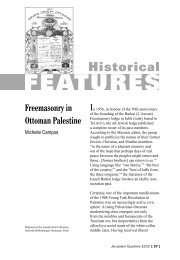
![In Search of Jerusalem Airport [pdf] - Jerusalem Quarterly](https://img.yumpu.com/49007736/1/180x260/in-search-of-jerusalem-airport-pdf-jerusalem-quarterly.jpg?quality=85)
